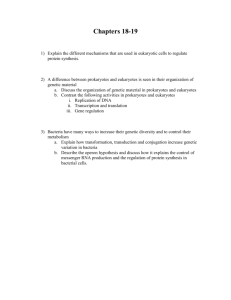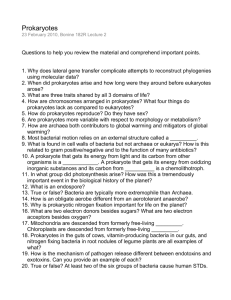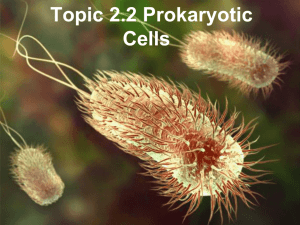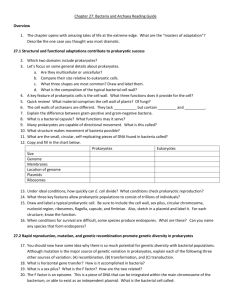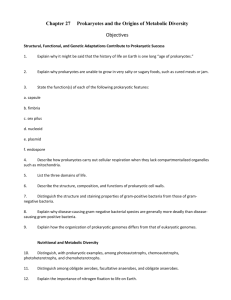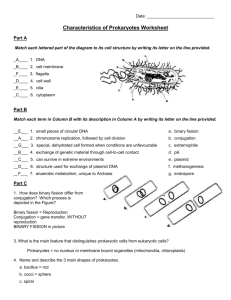CHAPTER 27
advertisement
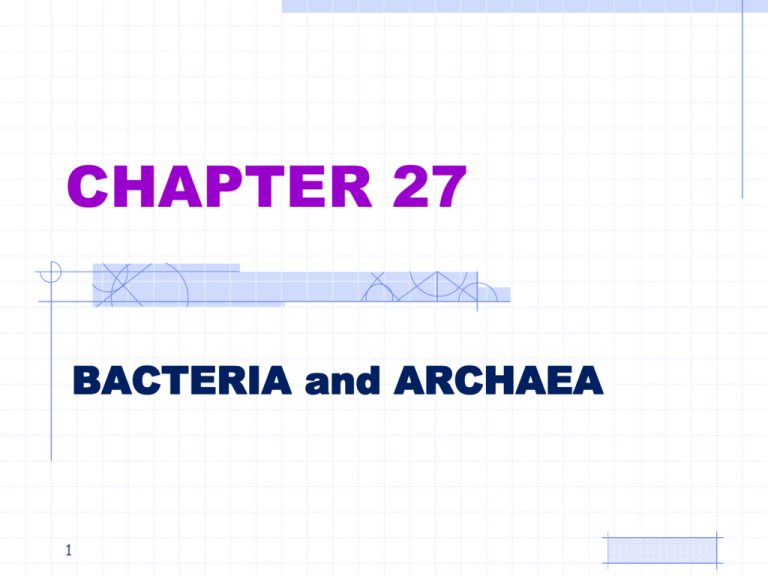
CHAPTER 27 BACTERIA and ARCHAEA 1 OVERVIEW 1. Earliest organisms on Earth 2. Dominate biosphere 3. Live everywhere 4. Commonly referred to as “bacteria” 5. Prokaryotic cells 6. Classified into two domains, Bacteria and Archaea, which differ in structure, physiology, and biochemistry 2 Bacteria on a Pin 3 I. Concept 27.1: Structure, Function, and Reproduction of Prokaryotes A. Structure 1. Most are unicellular, although some species form colonies 2. 3 major shapes • coccus-spherical • bacillus-rods • spirillum- spirals (helices) 3. Groupings • strepto—chains • staphylo—clusters • diplo—pairs 4 3 Major Shapes of Bacteria 5 6 B. Cell-Surface Structures 1. An important feature of nearly all prokaryrotic cells is their cell wall—maintains cell shape, provides physical protection, and prevents the cell from bursting in a hypotonic environment 2. Eukaryote cell walls are made of cellulose or chitin 3. Bacterial cell walls contain peptidoglycan, a network of sugar polymers cross-linked by polypeptides 4. Walls of archaea contain polysaccharides and proteins, but lack peptidoglycan 5. Cell membrane is internal to cell wall and other substances may be external to cell wall 7 6. Using the Gram stain, scientists classify many bacterial species into Gram-positive (stain blue) and Gram-negative (stain pink or red) groups based on cell wall composition 7. Gram-negative bacteria have less peptidoglycan and an outer membrane that can be toxic, and they are more likely to be antibiotic resistant 8. Many antibiotics target peptidoglycan and damage bacterial cell walls 8 Gram Positive/Gram Negative 9 9. A polysaccharide or protein layer called a capsule covers many prokaryotes 10. Some prokaryotes have fimbriae (also called attachment pili), which allow them to stick to their substrate or other individuals in a colony 11. Sex pili are longer than fimbriae and allow prokaryotes to exchange DNA 10 Capsule 11 Fimbriae 12 C. Motility 1. Most motile bacteria propel themselves by flagella that are structurally and functionally different from eukaryotic flagella 2. In a heterogeneous environment, many bacteria exhibit taxis, the ability to move toward or away from certain stimuli (Ex: phototaxis, chemotaxis, magnetotaxis) 13 14 D. Internal and Genomic Organization 1. Prokaryotic cells usually lack complex compartmentalization 3. The prokaryotic genome has less DNA than the eukaryotic genome 4. Most of the genome consists of a circular chromosome 3. Some species of bacteria also have smaller rings of DNA called plasmids some can provide resistance to antibiotics 5. The typical prokaryotic genome is a ring of DNA that is not surrounded by a membrane and that is located in a nucleoid region 15 Specialized Membranes of Prokaryotes 16 17 E. Reproduction and Adaptation 1. Prokaryotes reproduce quickly by binary fission and can divide every 1–3 hours 2. Many prokaryotes form metabolically inactive endospores, which can remain viable in harsh conditions for centuries • Endospores are resistant cells that form when an essential nutrient is lacking in the environment • They replicate the chromosome and surround it with a durable wall • Original cell disintegrates and leaves the endospore 18 3. Growth refers to increased number of cells and some factors affecting growth include temperature, pH, salt concentrations, and nutrient sources 4. Prokaryotes can evolve rapidly because of their short generation times 19 Endospore 20 II. Concept 27.2: Genetic Diversity in Prokaryotes • Prokaryotes have considerable genetic variation • Three factors contribute to this genetic diversity: – Rapid reproduction – Mutation – Genetic recombination 21 A. Rapid Reproduction and Mutation 1. Prokaryotes reproduce by binary fission, and offspring cells are generally identical 2. Mutation rates during binary fission are low, but because of rapid reproduction, mutations can accumulate rapidly in a population 3. High diversity from mutations allows for rapid evolution 22 B. Genetic Recombination 1. Additional diversity arises from genetic recombination 2. Prokaryotic DNA from different individuals can be brought together by transformation, transduction, and conjugation 3. A prokaryotic cell can take up and incorporate foreign DNA from the surrounding environment in a process called transformation 4. Transduction is the movement of genes between bacteria by bacteriophages (viruses that infect bacteria) 23 TRANSDUCTION 24 TRANSDUCTION 25 5. Conjugation and Plasmids • Conjugation is the process where genetic material is transferred between bacterial cells • Sex pili allow cells to connect and pull together for DNA transfer • A piece of DNA called the F factor is required for the production of sex pili • The F factor can exist as a separate plasmid or as DNA within the bacterial chromosome 26 CONJUGATION 27 6. The F Factor as a Plasmid • Cells containing the F plasmid function as DNA donors (male) during conjugation • Cells without the F factor function as DNA recipients (female)during conjugation • The F factor is transferable during conjugation and when transferred converts the female to a male 28 Conjugation—F Plasmid 29 30 31 7. The F Factor in the Chromosome (Hfr male) • A cell with the F factor built into its chromosomes functions as a donor during conjugation • The recipient becomes a recombinant bacterium, with DNA from two different cells 32 CONJUGATION—Hfr Male 33 34 35 8. R Plasmids and Antibiotic Resistance • R plasmids carry genes for antibiotic resistance • Antibiotics select for bacteria with genes that are resistant to the antibiotics • Antibiotic resistant strains of bacteria are becoming more common 36 III. Concept 27.3: Nuttitional and Metabolic Adaptations Greater diversity in prokaryotes than in all other kingdoms combined. A. 4 Major Modes of Nutrition: 1. Phototrophs obtain energy from light 2. Chemotrophs obtain energy from chemicals 3. Autotrophs require CO2 as a carbon source 4. Heterotrophs require an organic nutrient to make organic compounds 37 B. These factors can be combined to give the four major modes of nutrition: photoautotrophy (cyanobacteria, plants and algae) chemoautotrophy (probably earliest prokaryotes and unique to prokaryotes) photoheterotrophy (a few marine and halophilic prokaryotes) chemoheterotrophy (prokaryotes, protists, fungi, animals, and some parasitic plants) 38 39 C. The Role of Oxygen in Metabolism Prokaryotic metabolism varies with respect to O2: – Obligate aerobes require O2 for cellular respiration – Obligate anaerobes are poisoned by O2 and use fermentation or anaerobic respiration – Facultative anaerobes can survive with or without O2 40 D. Nitrogen Metabolism • Prokaryotes can metabolize nitrogen in a variety of ways • In nitrogen fixation, some prokaryotes convert atmospheric nitrogen (N2) to ammonia (NH3) 41 E. Metabolic Cooperation • Cooperation between prokaryotes allows them to use environmental resources they could not use as individual cells • In the cyanobacterium Anabaena, photosynthetic cells and nitrogen-fixing cells called heterocytes exchange metabolic products 42 Anabaena 43 IV. Concept 27.4: Molecular Systematics of Prokaryotic Phylogeny • Molecular systematics (especially ribosomal RNA comparison) has shown that prokaryotes diverged into archaea and bacteria lineages very early in prokaryotic evolution. • Genetic diversity of prokaryotes is immense. 44 45 A. Archaea 1. Archaea share certain traits with bacteria and other traits 2. 3. 4. 5. with eukaryotes Some archaea live in extreme environments and are called extremophiles Extreme halophiles live in highly saline environments Extreme thermophiles thrive in very hot environments Methanogens live in swamps and marshes and produce methane as a waste product •Methanogens are strict anaerobes and are poisoned by O2 •Decomposers 46 6. In recent years, genetic prospecting has revealed many new groups of archaea 7. Some of these may offer clues to the early evolution of life on Earth 47 B. Bacteria 1. Bacteria include the vast majority of prokaryotes of which most people are aware 2. Diverse nutritional types are scattered among the major groups of bacteria (based mainly on comparisons of rRNA) a. Proteobacteria—Largest and most diverse b. Chlamydias—Parasites of animals --Causes most common form of sexually transmitted disease in U. S. c. Spirochetes—Cause syphilis (Treponema pallidium) --Cause Lyme Disease 48 d. Gram-positive Bacteria e. Cyanobacteria—photoautotrophs with plant-like characteristics 49 50 51 V. Concept 27.5: Roles in the Biosphere A. Chemical Cycles 1. Prokaryotes play a major role in the recycling of chemical elements between the living and nonliving components of ecosystems 2. Chemoheterotrophic prokaryotes function as decomposers, breaking down corpses, dead vegetation, and waste products 3. Nitrogen-fixing prokaryotes add usable nitrogen to the environment 4. Prokaryotes can sometimes increase or decrease the availability key plant nutrients 52 B. Ecological Interactions 1. Symbiosis is an ecological relationship in which two 2. 3. 4. 5. 6. species live in close contact: a larger host and smaller symbiont Prokaryotes often form symbiotic relationships with larger organisms In mutualism, both symbiotic organisms benefit In commensalism, one organism benefits while neither harming nor helping the other in any significant way In parasitism, an organism called a parasite harms but does not kill its host Parasites that cause disease are called pathogens 53 VI. Concept 27.6: Impacts on Humans 1. Some prokaryotes are human pathogens, but others have positive interactions with humans 2. Pathogenic prokaryotes typically cause disease by releasing exotoxins or endotoxins • Exotoxins cause disease even if the prokaryotes that produce them are not present (very toxic--botulism) • Endotoxins are released only when bacteria die and their cell walls break down (food poisoning) 3. Many pathogenic bacteria are potential weapons of bioterrorism 54 B. Prokaryotes in Research and Technology 1. Experiments using prokaryotes have led to important advances in DNA technology 2. Prokaryotes are the principal agents in bioremediation, the use of organisms to remove pollutants from the environment 3. Some other uses of prokaryotes: •Recovery of metals from ores •Synthesis of vitamins •Production of antibiotics, hormones, and other products 55 Gleocapsa 56 Nostoc 57 58 You should now be able to: 1. Distinguish between the cell walls of gram-positive and gram- negative bacteria 2. State the function of the following features: capsule, fimbriae, sex pilus, nucleoid, plasmid, and endospore 3. Explain how R plasmids confer antibiotic resistance on bacteria 4. Distinguish among the following sets of terms: photoautotrophs, chemoautotrophs, photoheterotrophs, and chemoheterotrophs; obligate aerobe, facultative anaerobe, and obligate anaerobe; mutualism, commensalism, and parasitism; exotoxins and endotoxins 59


